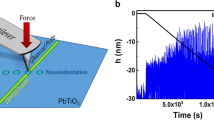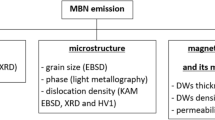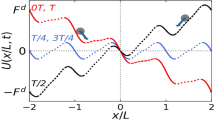Abstract
Crackling noise is a common feature in many dynamic systems1,2,3,4,5,6,7,8,9, the most familiar instance of which is the sound made by a sheet of paper when crumpled into a ball. Although seemingly random, this noise contains fundamental information about the properties of the system in which it occurs. One potential source of such information lies in the asymmetric shape of noise pulses emitted by a diverse range of noisy systems8,9,10,11,12, but the cause of this asymmetry has lacked explanation1. Here we show that the leftward asymmetry observed in the Barkhausen effect2 — the noise generated by the jerky motion of domain walls as they interact with impurities in a soft magnet—is a direct consequence of a magnetic domain wall’s negative effective mass. As well as providing a means of determining domain-wall effective mass from a magnet’s Barkhausen noise, our work suggests an inertial explanation for the origin of avalanche asymmetries in crackling-noise phenomena more generally.
This is a preview of subscription content, access via your institution
Access options
Subscribe to this journal
Receive 12 print issues and online access
$259.00 per year
only $21.58 per issue
Buy this article
- Purchase on SpringerLink
- Instant access to full article PDF
Prices may be subject to local taxes which are calculated during checkout




Similar content being viewed by others
References
Sethna, J., Dahmen, K. A. & Myers, C. R. Crackling noise. Nature 410, 242–244 (2001).
Durin, G. & Zapperi, S. in The Science of Hysteresis (eds Bertotti, G. & Mayergoyz, I.) 181–267 (Academic, New York, 2005).
Field, S., Witt, J., Nori, F. & Ling, X. Superconducting vortex avalanches. Phys. Rev. Lett. 74, 1206–1209 (1995).
Colla, E. V., Chao, L. K. & Weissman, M. B. Barkhausen noise in a relaxor ferroelectric. Phys. Rev. Lett. 88, 017601 (2002).
Mitchell, T. B., Bollinger, J. J., Itano, W. M. & Dubin, D. H. E. Stick-slip dynamics of a stressed ion crystal. Phys. Rev. Lett. 87, 183001 (2001).
Petri, A., Paparo, G., Vespignani, A., Alippi, A. & Costantini, M. Experimental evidence for critical dynamics in microfracturing processes. Phys. Rev. Lett. 73, 3423–3426 (1994).
Miguel, M. C., Vespignani, A., Zapperi, S., Weiss, J. & Grasso, J. R. Intermittent dislocation flow in viscoplastic deformation. Nature 410, 667–670 (2001).
Houston, H., Benz, H. M. & Vidale, J. E. J. Geophys. Res. 103, 29895–29913 (1998).
Mehta, A. P., Dahmen, K. A. & Ben-Zion, Y. Universal shape profiles of earthquake ruptures. cond-mat/0403567 (2004).
Spasojevic, D., Bukvic, S., Milosevic, S. & Stanley, H. E. Barkhausen noise: elementary signals, power laws, and scaling relations. Phys. Rev. E 54, 2531–2546 (1996).
Durin, G. & Zapperi, S. On the power spectrum of magnetization noise. J. Magn. Magn. Mater. 242–245, 1085–1088 (2002).
Mehta, A., Mills, A., Dahmen, K. & Sethna, J. Universal pulse shape scaling function and exponents: a critical test for avalanche models applied to Barkhausen noise. Phys. Rev. E 65, 046139 (2002).
O’Brien, K. P. & Weissman, M. B. Statistical characterization of Barkhausen noise. Phys. Rev. E 50, 3446–3452 (1994).
Colaiori, F., Durin, G. & Zapperi, S. Shape of a Barkhausen pulse. J. Magn. Magn. Mater. 272–276, E533–E534 (2004).
Durin, G. & Zapperi, S. Scaling exponents for Barkhausen avalanches in polycrystalline and amorphous ferromagnets. Phys. Rev. Lett. 84, 4075–4078 (2000).
Döring, W. Über die tragheit der wände zwischen weisschen bezirken. Z. Naturforsch. a 3, 373–379 (1948).
Hubert, A. & Schäfer, R. Magnetic Domains (Springer, New York, 1998).
Rado, G. T., Wright, R. W. & Emerson, W. H. Ferromagnetism at very high frequencies. iii. Two mechanisms of dispersion in a ferrite. Phys. Rev. 80, 273–280 (1950).
Bertotti, G. Hysteresis in Magnetism (Academic, San Diego, 1998).
Alessandro, B., Beatrice, C., Bertotti, G. & Montorsi, A. Domain wall dynamics and Barkhausen effect in metallic ferromagnetic materials. i. Theory. J. Appl. Phys. 68, 2901–2908 (1990).
Zapperi, S., Cizeau, P., Durin, G. & Stanley, H. E. Dynamics of a ferromagnetic domain wall: avalanches, depinning transition and the Barkhausen effect. Phys. Rev. B 58, 6353–6366 (1998).
Mills, A. C., Hess, F. M. & Weissman, M. B. Statistics of the pinning field in a soft metallic ferromagnet. Phys. Rev. B 66, 140409(R) (2002).
Bishop, J. E. L. The contribution made by eddy currents to the effective mass of a magnetic domain wall. J. Phys. D 13, L15–L19 (1980).
Baldassarri, A., Colaiori, F. & Castellano, C. The average shape of a fluctuation: universality in excursions of stochastic processes. Phys. Rev. Lett. 90, 060601 (2003).
Schwarz, J. M. & Fisher, D. S. Depinning with dynamic stress overshoots: Mean field theory. Phys. Rev. Lett. 87, 096107 (2001).
Author information
Authors and Affiliations
Corresponding author
Ethics declarations
Competing interests
The authors declare no competing financial interests.
Supplementary information
Supplementary Information, Domain Wall Motion
Domain wall motion in a soft magnetic material under the application of a slow varying magnetic field. The field is applied along the vertical direction, first up and then reversed. The jerky motion of the domain wall as it interacts with defects yields the Barkhausen effect. (MOV 1450 kb)
Rights and permissions
About this article
Cite this article
Zapperi, S., Castellano, C., Colaiori, F. et al. Signature of effective mass in crackling-noise asymmetry. Nature Phys 1, 46–49 (2005). https://doi.org/10.1038/nphys101
Received:
Revised:
Accepted:
Published:
Issue date:
DOI: https://doi.org/10.1038/nphys101
This article is cited by
-
Crackling noise microscopy
Nature Communications (2023)
-
Mechanisms underlying pathological cortical bursts during metabolic depletion
Nature Communications (2023)
-
Mild-to-wild plastic transition is governed by athermal screw dislocation slip in bcc Nb
Nature Communications (2022)
-
Breakdown of Scaling and Friction Weakening in Intermittent Granular Flow
Scientific Reports (2019)
-
Playing with universality classes of Barkhausen avalanches
Scientific Reports (2018)



